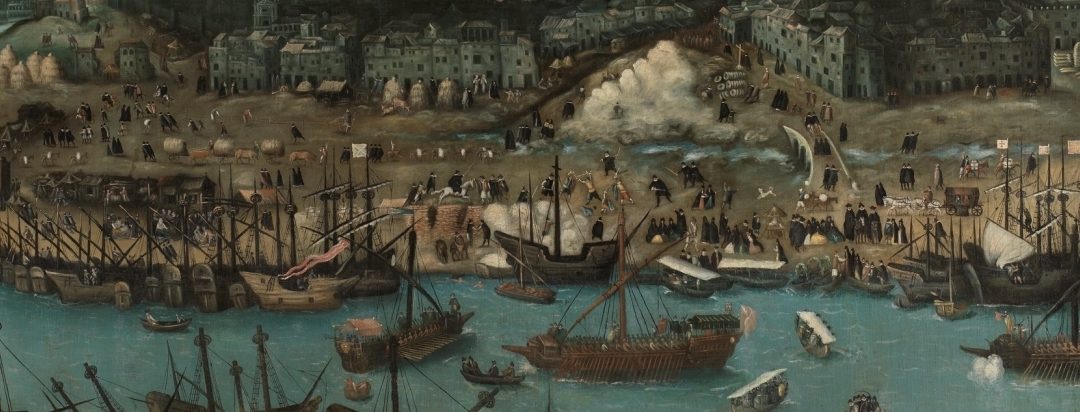—’Going round the world’ crossing the oceans was an extraordinary achievement, the result of a specific combination of knowledge and techniques involving the figure of the cosmographer.—
Being a cosmographer in the Renaissance meant mastering knowledge (mathematics, astrology, astronomy, geography) developed mainly in universities, but also the correct mastery of a series of techniques linked to cartography, instrument construction, observation of the skies and the so-called “art of sailing”, which did not belong to the university context, but came from artisan cultures of different origins and traditions.
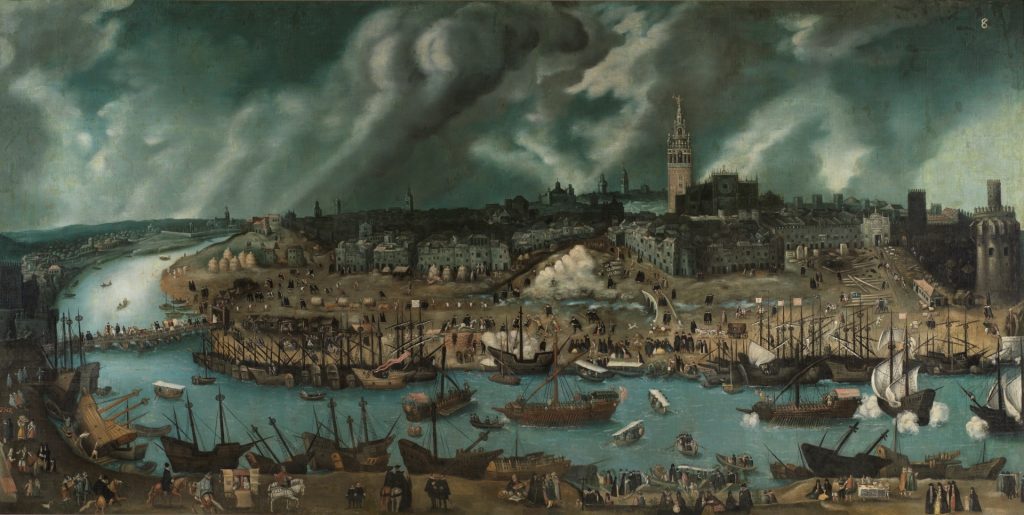
View of the city of Seville circa 1600, painting attributed to Alonso Sánchez Coello. Museo del Prado.
In this combination of scholarly and artisan knowledge, Cosmography became a field of its own, especially attractive and decisive for the courtly science of the European powers involved in colonial expansion. In fact, the court was often the space that acted as a link between academic knowledge and navigation practices. This special symbiosis took place, at the end of the fifteenth century, in the courts of Portugal and Castile, giving rise to the birth and consolidation of Iberian cosmography, undoubtedly one of the most outstanding scientific and technological achievements of European Renaissance culture. However, the promotion of the development of cosmography was not a tendency exclusive to the Iberian courts, but, on previous occasions and in most cases afterwards, this also occurred in other environments, from Venice to London, from Genoa to Amsterdam, from Mexico to Manila, from Oman to Goa, from Malacca to Bahia.
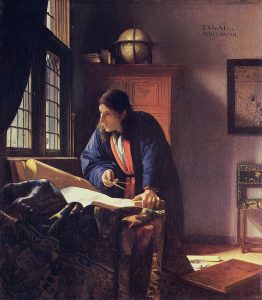
The geographer in his study, oil painting by Jan Vermeer, 1669. Wikimedia.
The praise that the cosmographer Pedro de Medina dedicated in his work, Arte de navegar (Art of Navigation), published in Valladolid in 1545, of the results that cosmography made it possible to obtain, leaves no room for doubt as to its significance: ‘It is a subtle skill so great that a man with a compass and some lines drawn on a chart knows how to go round the world, and knows day or night where to go, and where to turn, and how far to travel from one side to another; and that he succeeds in travelling over such a large and broad thing such as the sea, where there is no path nor signs’. That ‘subtle skill’, therefore, relied without doubt on precise instruments and cartographic techniques that allowed the way to sail around the globe to be read in the sky and on paper. Moreover, the cosmographer – like Pedro de Medina, which is why his praise was also a self-vindication – was the figure that made this feat possible, both theoretically and experimentally. We know the names and careers of more than a hundred cosmographers who, at one time or another, worked at the service of the Portuguese or Spanish courts. Their biographical trajectories give us an idea of the typical profile of the court scientist, under whose supervision a whole series of so-called mathematical trades also came together, which depended on royal power: cartographers, surveyors, instrument builders, navigators, etc.
An excellent representative of these cosmographers of his majesty was Rodrigo Zamorano. He was born in Medina de Rioseco in 1542 and died in Seville in 1623. In 1575 he was appointed professor of ‘cosmography and the art of navigation’ at the Casa de la Contratación (House of Commerce) in Seville. He had trained as a mathematician in Valladolid and Salamanca and was well known in the court, where he had taught mathematics and astronomy to various Castilian nobles. For thirty-eight years, Zamorano held the chair in Seville, retiring in 1613. From 1586 he was also a Piloto Mayor (head navigator), charged among other things with examining the navigators of the West Indies Route.
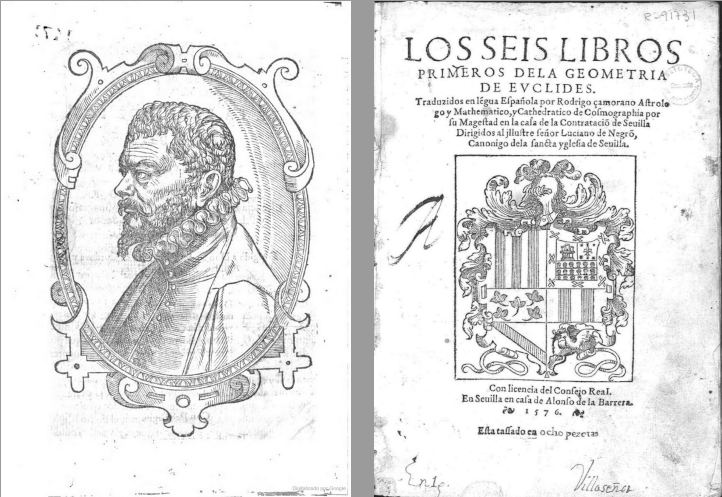
On the left, portrait of Rodrigo Zamorano, anonymous engraving included in his Repertorio y razón de los tiempos (Seville, 1594). Wikimedia. On the right, title page of Rodrigo Zamorano’s translation of the first six books of Euclid’s geometry (Seville, 1576). Wikipedia.
Zamorano’s tasks, in fact, were immense and exceeded the theoretical obligations of his two posts. In 1582, he reminded Philip II of some of these things, hoping for a financial reward, since they exceeded what was stipulated in his appointment (the courtier scientist was also a strict bureaucrat): ‘I observed some eclipses to ascertain longitudes in all places, both in Spain and in all the Indies […] I spent a lot of money on making some instruments […] in the fleet that went into the Strait of Magellan, I attended the drawing up of the log, from which the sea charts were made […] I did this alone because there were no other cosmographers, I did all the astrolabes, sextants, ship’s compasses, sailing regulations and all the equipment for rigging related to the art of sailing’. Rodrigo Zamorano was also the author of the first Spanish translation of the first six books of Euclid’s Geometry, a work printed in Seville in 1576. He also published a Compendio del Arte de navegar (Compendium of the Art of Navigation) in 1581 and a Cronología, repertorio y razón de los tiempos (Chronology, Cataloguing and Calculation of Times) in 1585, always in Seville. His other works on astronomy and also on architecture and mathematics, remained handwritten.
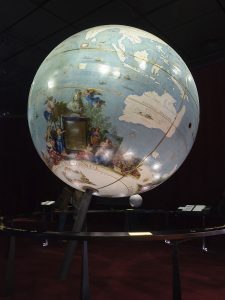
Terrestrial globe made by the Franciscan cosmographer Vincenzo Coronelli around 1681, now on display in the Bibliothèque Nationale de France. Wikimedia.
All these cosmographers of the king had to have solid mathematical training and, before obtaining a royal appointment to any of the posts, had to show proven experience. It should be noted that all of them left a huge number of writings on mathematics, astronomy, chronology, astrology, cartography, navigation and geography, although only a small part of this managed to reach the printing press. The scientific writings of the king’s cosmographers could not be made public without the express order of the monarch. In a way, the manuscripts written while working in an occupation of the court, as servants of the king as they were called, belonged to the monarch. Therefore, when any of these post holders died, normally all their papers remained in the Alcazar of Madrid, in the hands of the Council of the Indies, or in Seville, in the Casa de la Contratación, and were passed on to their successor.
In this sense, cosmographic matters were a matter of the State, because the effectiveness of colonial enterprise depended on them. Therefore, they needed to be protected from the rapacity of rivals. In more than one respect, Iberian cosmography was, in fact, a ‘secret science’, as the historian of science Maria Portuondo called it a few years ago. The paradox is that, in other respects, it was the most public science of the moment, as demonstrated by the thousands of copies of the navigation manuals published, the translations of the same into the main European languages, the widespread success of the production of terrestrial globes, maps and atlases and the prosperity that the artisan industry of the making of navigation instruments ended up having.
José Pardo Tomás
IMF-CSIC
How to cite this paper:
Pardo Tomás, José. The court, a space for science. Sabers en acció, 2020-12-11. https://sabersenaccio.iec.cat/en/the-court-a-space-for-science/.
Find out more
You can find further information with the bibliography and available resources.
Recommended reading
Carrió Cataldi, Leonardo Ariel. Temps, science et empire. Conceptions du temps au XVIe siècle dans les monarchies ibériques. París: Scuola Normale Superiore et École d’Hautes Études en Sciences Sociales; 2015.
Portuondo, Maria. Ciencia secreta. La cosmografía española y el Nuevo Mundo. Madrid: Marcial Pons; 2013.
Sánchez Martínez, Antonio. La espada, la cruz y el Padrón: soberanía, fe y representación cartográfica en el mundo ibérico bajo la Monarquía Hispánica, 1503-1598. Sevilla: CSIC; 2013.
Studies
Acosta Rodríguez, Antonio et al. La Casa de la Contratación y la navegación entre España y Las Indias. Sevilla: CSIC; 2004.
Cañizares-Ezguerra, Jorge. Nature, empire and nation : explorations of the history of science in the Iberian world. Stanford: Stanford University Press; 2006.
Esteban Piñeiro, Mariano; Vicente Maroto, Isabel. La ciencia y el mar. Valladolid: Fundación Carolina – Centro de Estudios Históricos e Iberoamericanos; 2006.
Rubiés, Joan Pau. Travellers and Cosmographers. Studies in the History of Early Modern Travel and Ethnology. Farmhan: Ashgate; 2007.

